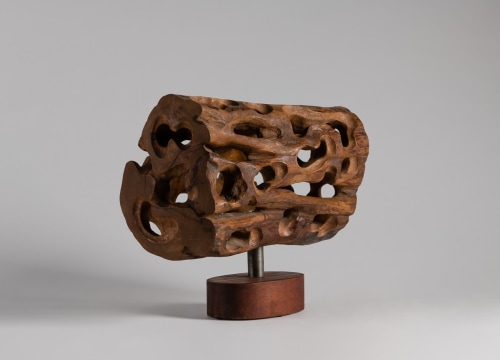
Mario Dal Fabbro was born in 1913 in Cappella Maggiore in Treviso, Italy, into a family of furniture-making craftsmen. He studied in Venice at the Institute for Decorative and Industrial Arts and at the Regio Magistero Artistico, majoring in art and design and graduating with honors in 1938. Trained as a sculptor, his belief that beauty could be conferred even to implements of everyday life allowed him to transition easily into the field of design. Dal Fabbro took an active role in his family’s furniture business, as designer, craftsman and administrator. He mastered the design and construction of all types of furniture, and moved on to accepting commissions for private individuals and furniture houses. He began researching all manner of modern materials and technologies, making everything from children’s furniture to automatic wooden mechanisms, and wrote about his discoveries. Throughout his career, he referred to himself as designer, writer, craftsman and sculptor.
A life-long penchant for new adventures—evident in both his work and his diverse interests—took Dal Fabbro to New York City in 1948. Excited to explore this post-war landscape of unlimited opportunities, he was armed with a great will to succeed and very little else, including an extremely limited knowledge of English. He knocked on the doors of publishing houses, boldly offering up his latest manuscript. A short year later, his “Modern Furniture: Design and Construction” made it into print. Ultimately, he published 12 books on related subjects, as well as pieces in The New York Times, House & Gardenand several other international publications.
Meanwhile, Dal Fabbro continued to work as a designer. As department head at J.G. Furniture in New York and Quakertown, Pennsylvania, he was in charge of all planning and technical developments for the design and installation of seating facilities in auditoriums, theaters and lecture halls. He also worked for Knoll and Paul McCobb Design Associates. Increasingly fascinated by the application of sculptural forms and principles to furniture design, he gradually returned to his original passion: sculpting.
By 1968, Dal Fabbro was dedicating himself full-time to his sculpture, applying his extraordinary manual skills, technical expertise and in-depth knowledge of wood to the creation of fluid and dynamic shapes. The freedom of his abstract forms seduces the eye, enticing the viewer to follow their rhythmic lines. His connection to the wood is evident in the way he highlights the natural beauty of its density, color and grain. He confers malleability upon the material that shows his sensitivity to its texture and tensile strength. The result is the constant interaction of solid and void, mass and movement, for pieces that are supremely architectonic and structured yet very sensuous and tactile.
As the artist himself describes it, “My preoccupation with sculpture is not with the volume and mass per se, but with the lines that delimit and circumscribe them. My goal is to represent spatially the complexity of profiles, the dimensions of forms which constantly seem to rearrange themselves in space and set themselves between the empty space and the concrete form.”
